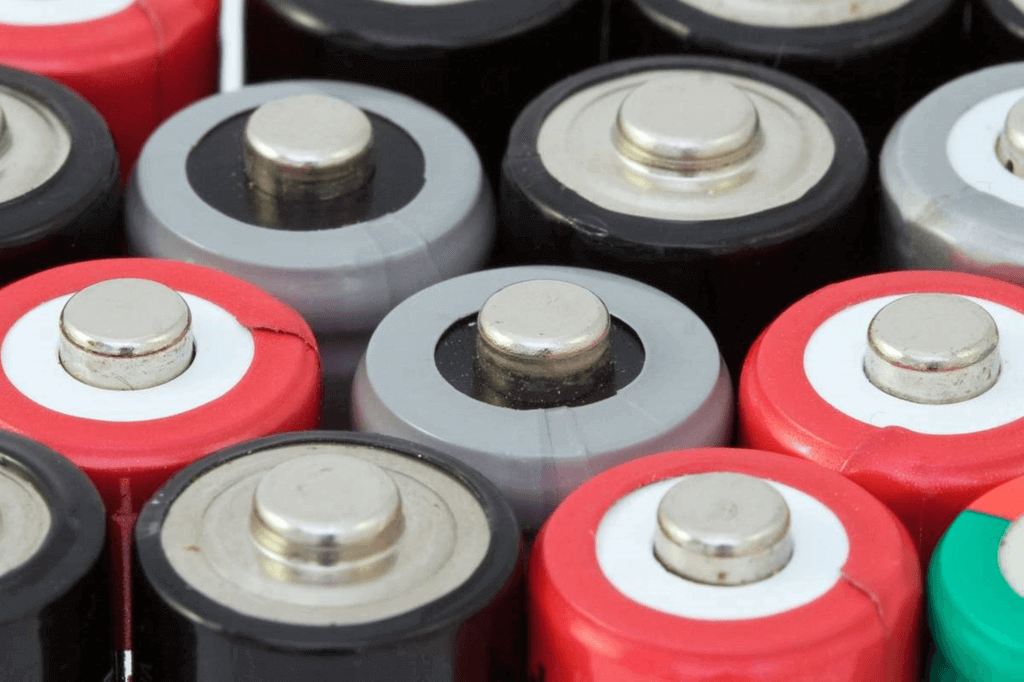National Battery Day
National Battery Day is observed next on Wednesday, February 18th, 2026 (75 days from today).

Every year February 18 is National Battery Day celebrated to honor and appreciate the convenience that batteries bring to our daily lives. Nowadays, we can easily see the presence of batteries in many different devices and almost everyone is benefiting from batteries.
A battery is a device that stores energy in the form of chemical energy. When we use it, this energy will gradually convert into electricity.
The battery is arranged to be assembled for portable electronic and telecommunications equipment. Make it possible for us to use those devices. In the event that it is not plugged in, connect the device to a power source.
Currently, batteries have many shapes such as: square, flat, ingot, coin ... but all have the use of providing power for devices.
Batteries are a common source of power for many personal devices, from home to industrial applications. There are many different types and sizes of batteries corresponding to a lot of power-consuming devices from wristwatches, children's toys, mobile phones, tablets to large batteries for electric vehicles, .. Batteries were, are and will be a popularly used energy storage tool not only in the present but also many years into the future.
History of the Battery
National Battery Day commemorates the birth of Alessandro Volta on February 18, 1745.
One of the greatest and most remarkable human inventions of the past 400 years is electricity. The first electric currents could have been generated before that, but it was not until the late 1800s that humanity saw concrete applications of electricity. That's 250,000 filament bulbs that lighted the Consumer Exhibition in Chicago, USA in 1893 or made a bridge over the Seine, Paris glow at the World's Fair in 1900.
However, the first electric currents were created by humans many years before that. In 1963, during the construction of a railway line near Baghdad, workers discovered "Parthian batteries" dating back up to 2,000 years in an ancient crypt. These are the earliest batteries in human history made by the hands of the Parthians, a people of Northern Persia.
Among the relics found in the tomb, archaeologists have found a clay jar or vase filled with vinegar with an iron rod inserted in the center then sealed with glass. Around the iron bar is wrapped by a coil with copper plates. Each vase is about 15 cm high, the copper tube is about 4 cm in diameter and 12 cm long. After rebuilding and testing with a similar version, the scientists found that the "battery battery" was capable of generating a current of 1.5 to 2 V between the iron pillar and the copper plate.
Thereby, scientists have predicted that the ancient Parthians used electric tools to plated gold and silver on objects as early as 250 BC. Many scientists believe that the Parthians only used these tools for plating purposes, but did not see it as a source of energy. More archaeological evidence shows that the ancient Egyptians also knew how to plated antimony on copper objects more than 4300 years ago. Other archaeological remains also show that the Babylonians also discovered and used the technique of using grape juice as an electrolyte to plated jewelry with gold.
1786 - A pair of dead prostheses that move!
In 1786, while giving a lecture, professor of Physiology Luigi Galvani (1737-1798) at the University of Bologne, Italy, stabbed a skinned frog with a metal rod. Due to the fact that the frog was placed on a metal table, the frog's legs twitched. Galvani was surprised by this phenomenon and after a few days of research, he realized that the prosthetic leg twitched when the tip of the metal rod hit and touched the metal table below.
Another day, Galvani used a copper hook to dry the fake legs above an iron bar on the balcony. Galvani has noticed that when the wind blows, the frog's legs swing and touch the iron rod and immediately, the frog will twitch. He pondered to try to explain this strange phenomenon and an idea popped into his head: electricity. Galvani concludes that electricity is present in everything and even in prosthetic legs. He named this type of electricity "biological electricity" and published his findings in a paper that shocked European scientists with this new type of electricity.
Today, we all know that Galvani was mistaken when he thought that it was the electricity of the organism and he just stopped at the phenomenon without understanding the cause of electricity generation. However, Galvani's discovery came very close to the principles that paved the way for later battery construction.
Alessandro Volta (1745-1827) was one of the most famous professor of physics at the University of Pavie, Italy. Prior to that, Volta had done many studies to enhance the electrical properties of Laiden bottles. Before that, he proposed a model of "electric pistol" for long-distance communication. The "electric pistol" is connected to an iron wire and placed on wooden stakes extending from Milan to Como, Italy. The methane gas tank is connected to the iron wire. When it wants to send an encrypted message, the "electric pistol" will "fire" a spark and the receiver will "read" the messages on the methane bottle. His model was never actually built, though.
Since Galvani published his findings on "organism electricity" in 1791, in many large European laboratories, a series of scientists have carried out experiments with Galvani's amphibians. Someone connected the prosthesis to a Leiden bottle (the earliest form of a condenser, a glass bottle that stores static electricity between the two electrodes inside and outside the bottle) and noticed that the frogs had violent twitches bouncing. With the above experiment, scientists began to doubt Galvani's "bioelectric" hypothesis. Among those who oppose the theory is Alessandro Volta.
For the amphibians experiment, Volta was not interested in the phenomenon of simple convulsions, more deeply, he was trying to find out where the electricity came from to make the clones twitch. Volta noticed that the flippers only twitched when two different metals were in contact. After further research, Volta further discovered that electricity is generated by a chemical reaction and that the twitching of the frog's legs occurs only when two different metals come into contact in a salt solution. Specifically, saline solution exists inside the muscle of the frog leg.
Continuing his research, in 1800, Volta made a series of experiments using zinc, lead, tin and iron as the negatively charged plate (cathode); and copper, silver, gold, graphite as a positively charged plate (anode). Then, he arranged the left poles alternately with each other, separated by a piece of paper soaked in salt solution. Finally, he connected the beginning to the end with a wire and noticed that an electric current was flowing. This is the first battery of mankind called "Volta battery". The reason the word pin or more precisely pile is given to this device is because it is a stack of copper and zinc round pieces shaped like a stake.
Also in 1800, Volta published his discovery of a stable power supply before the Royal Scientific Council in London to the witness and admiration of many scientists from all over Europe. With this invention, Volta's name became famous everywhere and was recognized as a great contributor to the development of mankind.
However, France was the first country to recognize Volta's invention because at that time, France was trying to access many advances in science and technology, so it was ready to accept any new suggested ideas. Not long after that, Volta was invited to France and taught at the French Academy of Sciences on his electrical studies. Even many of his lectures were followed by Napoleon Bonaparte
In the same 1800, the Cornish physicist and chemist Humphry Davy (1778-1829) began experimenting with the chemical effects of electric current and discovered that electric current was capable of separating particles substance in solution that we know today as electrolysis. Based on Volta's model, Davy built the largest and most powerful electric battery to date in the basement of the Royal Academy of Sciences. Witnesses reported that his battery model made an electric arc lamp shine like never before.
Two years later, in 1802, English chemist William Cruickshank designed the first model of a battery that could be manufactured on an industrial scale. Cruickshank proposed a method of using sheets of zinc and copper of the same size, interspersed with each other, placed in a long rectangular wooden box and glued together. The inside of the box has grooves to hold the metal plates in place and is filled with water filled with salt water or diluted acid as the electrolyte. This design has the advantage over the original Volta model in that it doesn't dry out and can deliver stronger currents. Cruickshank's battery model is the same as the wet battery we still use to this day.
From rechargeable batteries, wet batteries to dry batteries.
In 1836, British chemist John F. Daniell developed a more complete version of the battery with improved efficiency and more stable current output than the original Volta or Cruickshank. However, until then, all batteries were primary batteries, meaning that they could only be used once and could not be charged for reuse. In 1859, the first rechargeable battery was invented by French physicist Gaston Planté. It was a battery with lead plates separated by flannel and placed in dilute sulfuric acid. The battery will be recharged by adding acid for reuse. This model is still in use today under the names of wet or wet batteries (wet bottles) or carbon zinc batteries.
In 1866 in France, engineer Georges Leclanché (1839-1882) built a wet battery with electrodes immersed in an electrolyte solution. However, not long after that, he came up with an initiative to improve the battery by using ammonium chloride solution and then sealing the battery. This initiative marks the birth of the next generation of dry batteries. The new generation of batteries allows the battery to be used in many different locations, withstand strong vibration movements without fear of electrolyte spillage like wet batteries. In addition, the battery is also made into a tube or box inside containing other battery components such as the anode made of zinc (anode) and the cathode consisting of manganese dioxide and carbon in an 8:1 ratio (cathode). The electrode pool may also contain additional zinc chloride.
In 1881, Camille Faure built a battery that used lead oxide pile strips as electrodes to replace the lead plates in previous wet batteries. This allows for a much stronger and more stable current to be generated. This is the basis for the development of later wet batteries with many different types of electrodes.
In 1899, scientist Waldemar Jungner from Sweden invented the nickel-cadmium (NiCd) battery. This is a generation of batteries that use nickel as the cathode and cadmium as the anode. However, NiCd batteries are not wildely applied due to their high manufacturing cost. Two years later, the famous inventor Thomas Edison developed another battery model by using iron to replace cadmium as the anode to help reduce the cost of battery materials. However, Edison's Nickel-Iron battery model suffered from serious disadvantages: low power, poor performance at low temperatures, and high self-discharge. All of the above disadvantages prevent Edison's batteries from being put into production and widely used.
It was not until 1932 that Shlecht and Ackermann succeeded in improving NiCd batteries with strong currents and long life. The innovative solution of the two inventors is to equip additional panels to separate the electrodes into many compartments. In 1947, George Neumann continued to perfect the model by creating a NiCd battery generation with many sealed internal baffles.
Many years later, the rechargeable and portable batteries are only still NiCd batteries. In the 1990s, environmental issues became the top concern in Europe and scientists began to pay attention to NiCd batteries due to their ability to handle toxic chemicals after use. Laws were enacted to limit the use of these elements and switch to more environmentally friendly Nickel-Iron Hydrid (NiMH) batteries. However, similar to NiCd batteries, NiMH batteries have not really achieved the expected efficiency and researchers continue to develop a better generation of batteries. This is the springboard that sets the stage for the birth of lithium-ion (Li-ion) batteries.
Li-ion battery was born and developed to this day.
The first Li-ion battery was proposed in the 1970s by American chemist Michael Stanley Whittingham (1941) from Binghamton University using titanium sulfide and pure lithium metal as the electrodes. However, because Lithium is a highly reactive metal, when exposed to air, it can easily cause dangerous chemical reactions. Therefore, the battery model using pure lithium as anode was not accepted. Around the same time, J. O. Besenhard at the University of Munich discovered the reversible ion exchange property between graphite and the cathode using metal oxides.
Next, in 1979 at Oxford University, John Goodenough and Koichi Mizushima built a rechargeable battery that produced about 4 V using Lithium Cobalt Oxide (LiCoO2) as the anode and pure lithium as the cathode. LiCoO2 is a positively charged conductor with high stability that can supply lithium ions to generate electric current. This capability has opened up the prospect of using LiCoO2 as an anode for completely new generations of easily rechargeable batteries.
In 1977, Samar Basu from the University of Pennsylvania demonstrated the feasibility of making and using an electrochemical battery with lithium and graphite electrodes. Not long after that, this model was officially built by engineers at Bell Laboratories (now AT Labs).
In 1980, Rachid Yazami further demonstrated the electrochemically reversible properties of lithium in graphite. However, the organic substances used as electrolytes in this new generation of batteries decompose during charging. Therefore, Yazami proposed a mixture of solid organic matter that is stable during charging as an electrolyte. Yazami's electrolyte model is still used in Li-ion battery generations to this day.
In 1983, Michael M. Thackeray, Goodnewa and colleagues determined that it was possible to use the mineral Manganese Spinene to make anodes for Li-ion batteries. This is a mineral with good electrical conductivity, low cost and stable operation. Although there is still the disadvantage of being gradually consumed during the charging process, it can still be overcome by chemical editing measures. Until 2013, Manganese Spinen continued to be used for commercial Li-ion battery generations.
In 1985, Akira Yoshino assembled the first battery model based on all the elements of previous success, using carbonate material to help keep lithium ions in an electrode making LiCoO2 more stable in the air. It is for this reason that the Li-ion battery generation has been perfected and is much safer than before.
In 1991, Sony Electronics Corporation officially commercialized Li-ion batteries on an industrial scale. To date, most research activities have revolved around improving the performance of Li-ion batteries. Besides powering mobile phones, laptops, digital cameras, power tools and medical devices, Li-ion batteries are now also used in electric vehicles. This is the most remarkable battery generation to date due to its specific level of energy storage, simple design, high efficiency, stable current, low maintenance cost and quite environmentally friendly school.
This was followed by the event that Bellcore Company officially commercialized Li-Ion Polymer batteries in 1994 after the research process. The next step is battery, the appearance of li-ion battery with manganese cathode, li-phosphate battery is continuously improved and perfected by scientists to officially commercialize. Scientists predict that the next generation of batteries will be developed based on advances in nanotechnology that will increase the performance, size and life of the battery.
Observing National Battery Day
Let's spend National Battery Day to celebrate scientist Volta and the scientists who improved and invented the battery. In daily life, how many devices need batteries? Take the time to learn more about the existing batteries. Or you can engage in research to further develop different types of batteries. Use hashtag #NationalBatteryDay to share to everyone around.
Observed
National Battery Day has been observed annually on February 18th.Dates
Sunday, February 18th, 2024
Tuesday, February 18th, 2025
Wednesday, February 18th, 2026
Thursday, February 18th, 2027
Friday, February 18th, 2028


